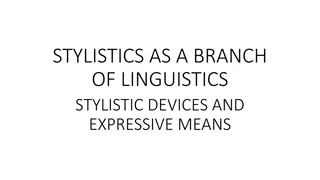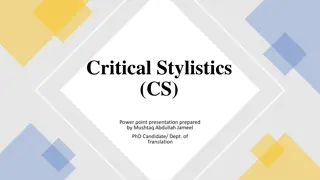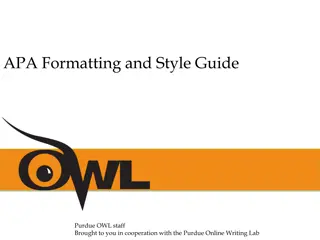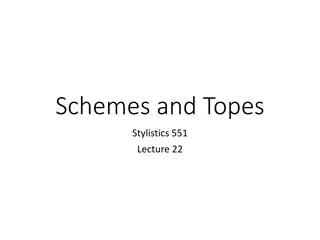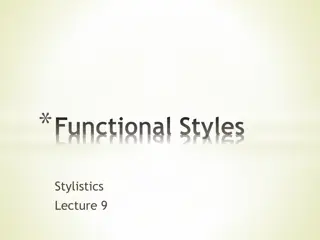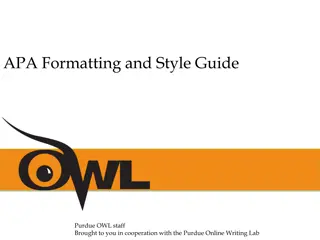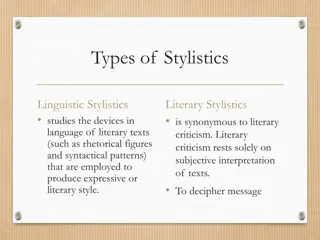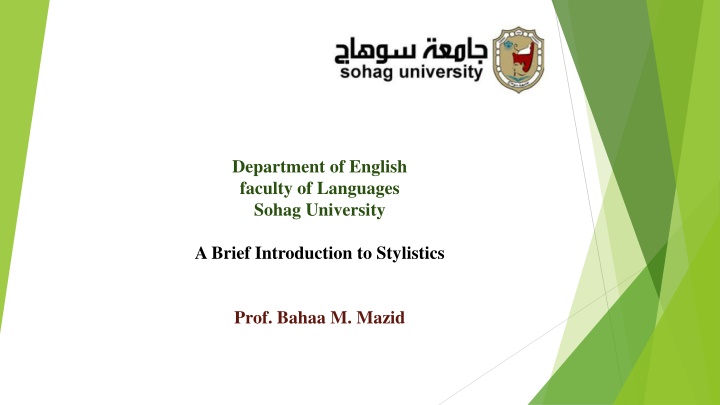
Exploring Stylistics: A Brief Overview and Definition
"Discover the science of stylistics and its role in analyzing linguistic features of literary texts to understand reader interactions and textual effects. Learn about the origins, growth, and applications of stylistics in language studies."
Download Presentation

Please find below an Image/Link to download the presentation.
The content on the website is provided AS IS for your information and personal use only. It may not be sold, licensed, or shared on other websites without obtaining consent from the author. If you encounter any issues during the download, it is possible that the publisher has removed the file from their server.
You are allowed to download the files provided on this website for personal or commercial use, subject to the condition that they are used lawfully. All files are the property of their respective owners.
The content on the website is provided AS IS for your information and personal use only. It may not be sold, licensed, or shared on other websites without obtaining consent from the author.
E N D
Presentation Transcript
Department of English faculty of Languages Sohag University A Brief Introduction to Stylistics Prof. Bahaa M. Mazid
What Is Stylistics? Stylistics is the science which explores how readers interact with the language of (mainly literary) texts in order to explain how we understand, and are affected by texts when we read them.
Stylistics is the scientific study of style, which can be viewed in several ways. More technically, stylistics is the study of the linguistic features of a literary text: phonological, lexical, syntactical, which directly affect the meaning of an utterance. Stylistics is the branch of general linguistics that deals with: The investigation of the inventory of special language media which by their ontological features secure the desirable effect of the utterance and Certain types of texts (discourse) which due to the choice and arrangement of language means are distinguished by the pragmatic aspect of the communication a. b.
Definition of Stylistics (continued) Stylistics, then, is a sub-discipline which grew up in the second half of the twentieth century: It s beginnings in Anglo-American criticism are usually traced back to the publication of the books listed below: - Freeman, Donald, Linguistics and Literary Style. - Leech, Geoffrey, A Linguistic Guide to English Poetry. - Sebeok, Thomas , Style in Language. - Fowler, Roger, Essays on Style in Language. These books are collections of articles, some of which were either conference papers or articles published in journals
Stylistics must take into consideration the (output of the act of communication), but stylistics must also investigate the functional peculiarities of the means of communication which may ensure the effect sought. A current definition of stylistics and style is that structures, sequences and patterns which extend, or may extend, beyond the boundaries of individual sentences define style, and that the study of them is stylistics.
Stylistics is the description and analysis of the variability of linguistic forms in actual language use. The concepts of (style) and (stylistic variation) in language rest on the general assumption that within the language system, the same content can be encoded in more than one linguistic form. Operation at all linguistic levels (e.g. lexicology, syntax, text linguistics, and intonation), stylisticians analyze both the style of specific texts and stylistic variation across texts.
Therefore, Stylistics is concerned with the examination of grammar, lexis, semantics, as well as phonological properties and discursive devices . We use the term discursive devices to refer to the micro-linguistic tools that people use in interaction in order to construct a particular version of the world and their relationship to it. It might seem that the same issues are investigated by sociolinguistics , and indeed that is the case, however sociolinguistics analyses the above mentioned issues seen as dependent on the social class, gender ,age ,etc , while stylistics is more interested in the significance of function that the style fulfills.
Stylistics examines oral and written texts in order to determine crucial characteristic linguistic properties, structures and patterns influencing perception of the texts. Thus, it can be said that this branch of linguistics is related to discourse analysis , in particular critical discourse analysis , and pragmatics. Owing to the fact that at the beginning of the development of this study the major part of the stylistic investigation was concerned with the analysis of literary texts it is sometimes called literary linguistics, or literary stylistics.
Nowadays, however, linguists study various kinds of texts, such as manuals, recipes, as well as novels and advertisements . It is vital to add here that none of the text types is discriminated and thought to be more important than others. In addition to that , in the recent year so called ' media-discourses' such as films, news reports, song lyrics and political speeches have all been within the scope of interest of stylistics.
The Development of Stylistics In the twentieth century Stylistics can be seen as a logical extension of moves within literary criticism to concentrate on studying texts rather than authors. While in Nineteenth century literary criticism concentrated on the author, and the text-based criticism of the two British critics Richards and William Empson who rejected that approach and replaced it with the other approach called Practical criticism.
In many respects , however , stylistics is close to literary criticism and practical criticism . by far the most common kind of material studied is literary, and attention is largely text centered. Practical criticism concentrates on the literary texts themselves, and how readers were affected by those texts. In addition Practical criticism is matched by a similar critical movement in the USA called New criticism.
What is New Criticism? New Criticism is based on the description of literary works as independent aesthetic objects Practical Criticism and New Criticism share two important features: 1. An emphasis on the language of the text rather than it s author 2, An assumption that what criticism needed was accounts of important work of literature based on the intuitional reading outcomes of trained and aesthetically sensitive critics.
Although both practical and new criticism pay too much attention to the effect of the text on the readers, yet from the stylisticians point of view, it is not enough to criticize a text because intuition is not enough and we must analyze the text in detail.
Roman Jacobson who is a member of the Russian Formalists is one of the most influential linguists on stylistics for two reasons: 1. For his academic brilliance. 2. Because he linked various schools of linguistics together. Roman Jacobson moved from Moscow to Prague and joined the Prague Structuralists Circle who were interested and affected by his views. Later he moved to the USA where he carried his approach with him, which is now called STYLISTICS
Perhaps the most influential article is:(Closing statement: Linguistics and poetics) By Roman Jacobson who is an important figure who contributed to the development of Stylistics. Roman Jakobson s functions of language Roman Jakobson s Poetic Function Roman Jakobson proposes a model of language which comprises six key functions: The conative (The aspect of mental processes or behavior directed toward action or change and including impulse, desire, volition, and striving_ Phatic (relating to speech used to share feelings or to establish a mood of sociability rather than to communicate information or ideas) Referential (the content carrying component of a message) Emotive (the expression of attitude through a message) Metalingual, language used to describe language. Poetic (projects the principle of equivalence from the axis of selection into the axis of combination). 1. 2. 3. 4. 5. 6.
Types of Stylistics Stylistics is sometime called confusingly literary stylistics or linguistic stylistics. Linguistic stylistics the purest form of stylistics in that its practitioners attempt to derive from the study of style and language variation. The most recent studies in linguistic stylistics have tended to focus on applications of studies in discourse analysis and narrative organization to literary text study.
The most recent studies in linguistic stylistics have tended to focus on applications of studies in discourse analysis and narrative organization to literary text study. Burton (1980,1982)employs models for spoken discourse analysis based on Sinclair and Coulthard (1975)for the analysis of drama dialogue Short (1981) use analysis based on Gricean and speech act theory. Carter and Simpson (1982) use narrative models based on Labov (1972). Fowler (1981; 1982) exploits Hallidayan models from within systematic linguistics
Literary stylistics It established methods of close reading or practical criticism of texts, the procedures of literary stylistics remain traditional in character in spite of development in literary theory (e.g. post -structuralism) which challenge assumptions about the role of language in depicting literary realities.



